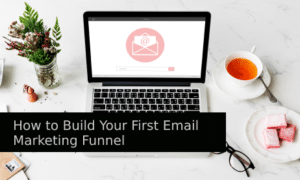These days, starting your e-commerce business can be challenging. With plenty of platforms available, you can start an online store with minimal upfront costs.
Most of these platforms are free or have attractive monthly plans that help you grow your business. So, you must research key business ideas to help you understand how to create a successful e-commerce store.
Here are the steps on how you can build your e-commerce brand from scratch and create a successful e-commerce business from home:
1. Find a product to sell
The first step if you want to make an e-commerce website is knowing what products you need to sell directly to consumers. In fact, this is one of the most challenging aspects of starting an online business and a common challenge of e-commerce businesses.
To find your niche, you need to consider what type of product you need to sell, to whom, and how you’ll distribute it. Whether you want to create hand-crafted products or look for generic ones, you must decide what works for you.
2. Research your competition
Research is key to your e-commerce store’s success. When choosing your products, it would be best to look at your competitors and their actions.
Here are a couple of things to consider when doing competitor analysis:
- What’s their business model?
- Are they selling numerous items or just a single product?
- What social media channels do they use?
- What’s their target market?
- How do they push sales?
- Competitor analysis allows you to identify better products to sell and give you a solid understanding of how to jumpstart an online business.
3. Validate your business idea
After determining that you should start a business and have an idea in mind, you need to validate it. You can start by chatting with prospective customers, knowing their needs and whether they’ll consider your solution.
Here are some ways that you can use to test your market:
- Look at customer reviews: A straightforward way to gauge your customers’ interest is to look at reviews. See how your customers respond, whether they like (or dislike!) it, and check the total volume of feedback. This gives you insight into the active market size, whether your business concept could avoid the pitfalls of your current offerings, or whether or not there are additions requested in reviews.
- Set up a landing page: Without setting up an entire site, you can create a preview landing page featuring your business, product or service. Ensure you quickly run down your features, pricing, and release window. etc. Also, place an email subscription signup prompt to start building your mailing list. This can be as simple as running social media and search ads targeting potential customers to drive traffic to your site. To make it easier for potential customers to access your landing page, you can also use a secure QR Code generator out there to create custom QR Codes for your marketing materials, such as flyers or business cards, which will allow them to quickly scan and access your page.
- Survey your potential customers: One of the best ways to validate your business is to talk with customers. For instance, if you run a DTC eCommerce store where you sell directly to the consumer, you can leverage their opinions to improve your business. However, you can also run online surveys before interacting with them in person.
4. Identify your target market
Who are your target customers? What are they looking for? What do you think they need? Can you spot e-commerce trends? Is there another organization that tends to them? What are their strengths and weaknesses?
Targeting a conventional customer base could be a better strategy. Instead, you need to know who you’re serving, and not everyone will be your customer, and that’s okay. So, how do you find your target demographic? Doing market research is an excellent starting point.
5. Write your business plan
Similarly, you must develop a roadmap to keep your business on track. As soon as you’ve come up with the basics, making a business plan lets you establish your goals and get into the particulars of what exactly you need to run your business and reach your target customers.
Also, if you’re planning to get a business loan, most investors and lenders will require you to develop a business plan. So keep it thorough and professional.
It should also include the following:
- The nature of your business
- What you’re selling
- How your business will help you earn money
- A list of your employees and staff
- Where you’ll be getting the money to finance your business
- Your business operation model
You must also keep your target audience in mind when developing your plan. If they’re investors, ensure you know what you’re doing. If it’s people that you’re hiring to work for you, then ensure that they can see your values and how they’ll be treated.
From the beginning to the end, your business plan will look something like this:
- Executive summary
- Company Overview
- Market analysis
- Products and services
- Marketing Plan
- Financial plan
- Logistics and operations plan
When writing down your plan, you need to know your goal. Usually, it will be a lot different if you’re writing one that can help you secure start-up finds or outline it for yourself.
You also need to keep a consistent tone throughout the document. One of the best ways to ensure this is to have one person write the entire thing and then ensure you have the time to edit the document thoroughly before submitting it to anyone outside your business.
Keeping your business plan short and to the point would be best. Ideally, it should be about 15 to 20 pages maximum. Similarly, it should be long enough to convey critical information without wasting time.
6. Register your business
Before selling online, you must register your business by picking a legal structure. You must also apply for your employer identification number and get the necessary licenses and permits to fit your business model.
After choosing your business’s name, you can check your local secretary of state’s site and the U.S. Patent and Trademark Office to check if the business name is available.
You also need to decide on your legal structure. A business entity type will help you know your online business’s legal and financial guidelines.
You can choose from a general partnership, corporation, LLC, or sole proprietorship. One of the advantages of an LLC is that it can also be opened by non-US residents. You must also consult a legal professional to ensure it fits your business correctly. When making your decision, especially if you opt for an LLC, it’s important to factor in the costs associated with your chosen legal structure, such as LLC cost by state.
7. Create your e-commerce business website
Once you’ve done the necessary paperwork, and you’ve officially registered your business, you can now create your e-commerce business site. Ideally, this site will serve as a storefront for your business when customers arrive, browse, and then place items in their shopping carts. A business site and its functionality are crucial to your success.
To start, you first need a domain name matching your business name. Then, you need to pick an e-commerce platform (e.g., SAP Spartacus) that fits your bandwidth for building and maintaining your online store.
Two of the most popular all-inclusive software, such as Shopify, and open source forums like Magento, allow you to run day-to-day business operations like managing your inventory, shipping your orders, and much more.
If you’ve decided to launch subscription box business model, then you’ll need a website that can accommodate and streamline recurring orders and recurring payments. Or, if you have already familiarized yourself with the definition of consignment and chosen this particular business model, you will need a website that can effectively handle consignment inventory management and facilitate communication between consignors and consignees.
Consider integrating a live chat solution into your website to allow prospective customers to reach out in real-time and make inquiries. This feature enhances customer engagement and support, contributing to a positive user experience on your e-commerce website.
8. Determine your shipping strategy
Consider what shipping policies you want to implement for your business. Setting up prices for your shipping can be complicated, and different sellers use various strategies in pricing their shipping.
Here are some routes you can take:
- Flat-rate shipping: With this strategy, vendors calculate the average product cost. They average all the shipping expenses for the past couple of months and then estimate the shipping costs per category. The vendors will then utilize the average costs as the flat-rate shipping costs of their products.
- Free Shipping: You can give your customers a sense that they’re getting a good deal – free shipping. However, your products might end up being costly, deterring some buyers. Test this on several products first and see what happens to your sales. Another way to do this is by offering free shipping once your customers reach a specific total in their order. Placing QR codes (generated via any of these best QR code generators) on shipped products can be used for collecting customer feedback which in turn helps you sell more.
- Real-Time Calculated Shipping Rates: These often rely on the integration with the shipping carriers you’ve chosen, as well as product dimensions, weight, and shipping addresses, to calculate the actual costs of a shipment. It will help if you input all your product weights and dimensions into the software to use this.
9. Market your business
How will people find you online when you’ve built your e-commerce store? How do you build a brand? You also need to know what type of audience you want to target. Who are they, and why do they like to purchase from you in the first place?
As soon as you have an answer to these questions, start making content and creating an e-commerce customer experience that appeals to them.
Here are several ways how you can market and have a solid marketing strategy your e-commerce business:
- Email Marketing
- Search Engine Optimization
- Online Reviews
- PPC Advertising
- Social Media Proof best practices
Over to You
So there you have it. Hopefully, you have a better idea of starting an e-commerce business in this ever-changing, modern world.
By applying some of these tips, hopefully, you’ll have what it takes to succeed in your industry. Also, always do your research so that you can decide what works best for your business. Good luck!




